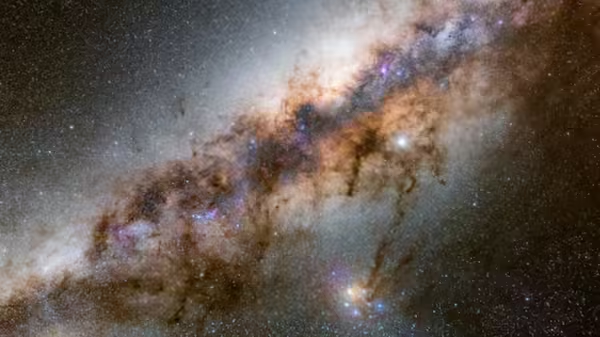
For decades, dark matter has been one of the universe’s greatest mysteries, an invisible force said to bind galaxies together and fuel the universe’s expansion. Now, a group of scientists believe they might have finally seen its footprint, glowing faintly at the center of the Milky Way.
Researchers from Johns Hopkins University and the Leibniz Institute for Astrophysics have detected a mysterious gamma-ray glow in our galaxy’s core, and they think it could be the long-sought-after dark matter revealing itself at last.
Add Zee News as a Preferred Source
Using data collected by NASA’s Fermi Gamma-ray Space Telescope, which has been mapping cosmic rays since 2008, the team discovered an eerie, diffused light emerging from the center of the Milky Way. What puzzled them most was that this light didn’t come from any known source, not stars, not black holes, not cosmic dust.
After careful analysis, they concluded that there were only two possible explanations:
It was being emitted by the spinning cores of dying stars, or
It was caused by the collision of dark matter particles.
If the latter is true, it would be the first-ever solid evidence of dark matter’s existence — a discovery that could rewrite our understanding of the cosmos.
“Dark matter dominates the universe and holds galaxies together,” explained Professor Joseph Silk, co-author of the study published in Physical Review Letters. “Gamma rays, and specifically the excess light we’re observing at the center of our galaxy, could be our first clue.”
Dark matter is believed to make up around 85% of the total matter in the universe, yet it cannot be seen, touched, or directly measured. It doesn’t emit, reflect, or absorb light, meaning scientists can only detect it through its gravitational effects on visible matter.
For years, astronomers have known something massive and unseen was influencing the movement of stars and galaxies. But they lacked proof, until now.
To test their theory, the researchers built a detailed model of how dark matter might be distributed throughout the Milky Way using a supercomputer. They then compared this simulation with the real gamma-ray data from Fermi, and to their astonishment, the patterns aligned almost perfectly.
According to Professor Silk, “The Milky Way was formed from a vast cloud of dark matter. The ordinary matter cooled down and fell into the central regions, dragging along some dark matter for the ride.”
As the galaxy evolved, dark matter from other systems likely drifted inward toward the galactic core, increasing the chances of collisions that release gamma radiation, possibly explaining the mysterious glow.
While the findings are groundbreaking, the mystery is not fully solved. Some scientists still believe the gamma rays could be emitted by dying stars or pulsars, highly magnetised, rotating remnants of massive stars.
To settle the debate once and for all, researchers are looking forward to the Cerenkov Telescope Array, currently being constructed in Chile. Once operational, it will be the world’s most powerful gamma-ray telescope and may finally confirm whether the light at the Milky Way’s center is indeed the long-awaited proof of dark matter.
If confirmed, this discovery could open a new chapter in astronomy, offering answers to questions that have baffled scientists for nearly a century. The mysterious glow may not just be another celestial phenomenon but the first sign of a cosmic giant that has silently shaped the universe since the beginning of time.